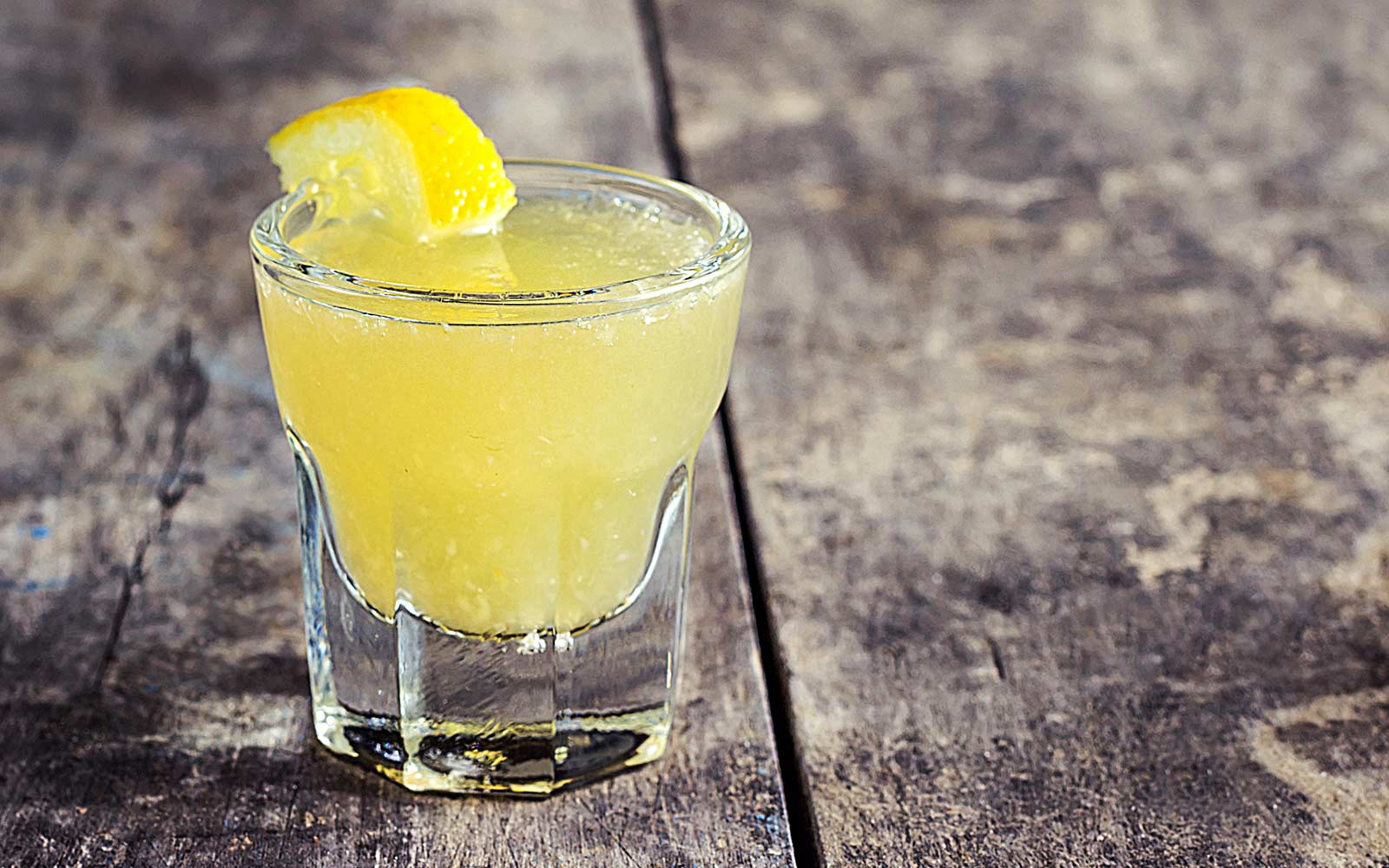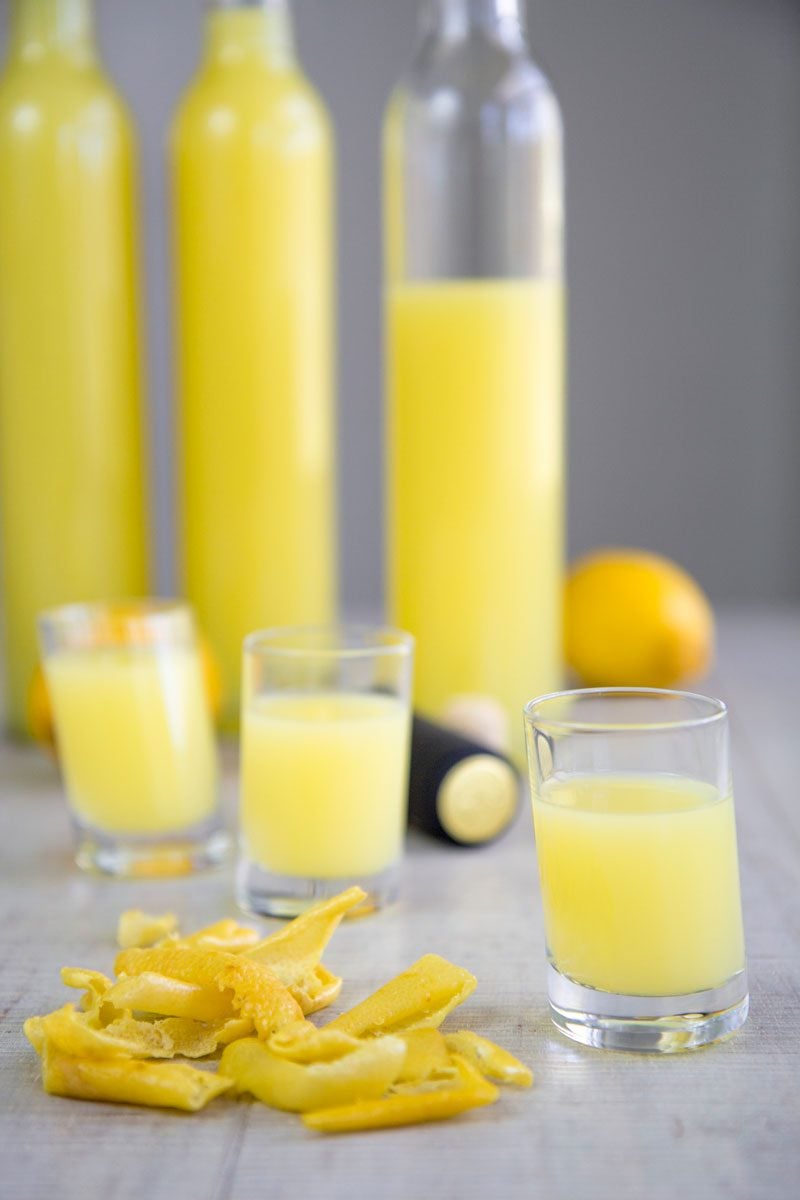Limoncello: The Italian Lemon Liqueur
Why there's no wrong way to enjoy this famous digestif

Written by Ellis Perry
Lemons are wonderful things, and limoncello is one of humankind’s nicest tributes to Citrus limon. Possibly indigenous to northwest India, lemons were known to the Romans by the second century BCE. Limoncello, a lemon-based liqueur with origins no less cloudy than those of the lemon itself, appears to have been around for a century.
We have it on the authority of our trusted Italian correspondent that the best limoncello is homemade. Of course it is. We’ve not made our own, but recipes for limoncello do indeed abound on the Internet — see links below.

Our experience is with both homemade and bottled limoncello, and while we prefer the former we have yet to develop a marked prejudice against the latter. We drink it more or less as Leaf.tv recommends:
Keep the limoncello in the freezer.
Serve after dinner. Limoncello is traditionally served as a digestivo, meaning it’s served after a large meal to help digest. Its sugary flavor will complement desserts.
Pour into liqueur glasses. Limoncello is traditionally taken without ice but served ice cold. On the Amalfi coast, it is served in small ceramic cups — roughly 1-1/2 oz. per serving — but any glass will do.
“More or less,” we say, because we enjoy limoncello as a digestivo, an aperitivo, as part of a cocktailo, and throughout the course of any given weekendo in the summer, or wherever the fish are jumping and the cotton is high. Divine stuff, really.
We hold limoncello in the same high regard we hold Campari, and it is perhaps no coincidence that these very different spirits (we use the word ‘spirits’ broadly) occupy opposite ends of the flavor spectrum: limoncello is sweet/sour to the same degree that Campari is bitter/quasi-medicinal. If Campari neat over ice is very much an acquired taste, a taste for limoncello over ice is too easily acquired. We are not sure whether limoncello is the yang to Campari’s ying, or the ying to its yang, but it is probably neither and the reference to Chinese geomancy is inappropriate and confusing.
The point is: if you’ve never had limoncello, we think you should try it. “Life is short,” said Hippocrates, “and the art is long. Opportunity is elusive, experiment is dangerous, and judgment is difficult.” Most of the time this makes for good counsel. But not here. In the case of limoncello, opportunity abounds, experiment is recommended, and judgment is easy. But Hippocrates was correct about our vita being a bit brevis. Get a bottle today.

We offer in closing a discovery we made a few years back, while dining at our favorite trattoria in Shanghai, Salute.
We no longer recall why we suddenly felt the urge to do this; but we did, and we’ve been recommending the concoction ever since. If you are waiting for simple but robust Italian fare – a pizza, let’s say – we know of no better aperitivo than this hard-hitting hybrid digestivo.
HOW TO MAKE HOMEMADE LIMONCELLO
epicurious
thekitchn
Food & Wine offers three recipes for limoncello-based cocktails. We love the fact that the feature photo is of Luxardo-brand limoncello. Sydney at BiteSipHairFlip shares this gem — limoncello and prosecco. Hailing as we do from cranberry country, we are excited to try SnappyGourmet’s cranberry + limoncello spritzer.
Limoncello is said to be gaining in popularity here in the United States. We hope not, and pray that reports to this effect are exaggerated. Consumer-demand for a thing tends often to diminish on aggregate the quality of the thing in question, and to debride it too of some of its cognoscenti-appeal. The democratization of interest in limoncello would doubtless be a boon to lemon-growers et al., with whom we’ve no grudge and who we wish well. Our strain of humanism is not so expansive as to be populist, however, not at least when it comes to spirits, fragrances, composers, and cats. Mozart has become ear-Skittles — and poor Erik Satie! None benefitted when Asian Leopard Cats (Prionailurus bengalensis) became trendy, least of all the poor little bengalensises themselves. We stopped wearing Dolce & Gabbana Light Blue when we discovered it is available at CVS and Walgreens.
If Smirnoff ever makes an “Ice” version of limoncello, and/or Ryan Seacrest ever tweets about it, we’ll be forced to make some difficult decisions.
Do have a bottle of Campari? You should.
Ellis Perry

Written by Ellis Perry
Lemons are wonderful things, and limoncello is one of humankind’s nicest tributes to Citrus limon. Possibly indigenous to northwest India, lemons were known to the Romans by the second century BCE. Limoncello, a lemon-based liqueur with origins no less cloudy than those of the lemon itself, appears to have been around for a century.
We have it on the authority of our trusted Italian correspondent that the best limoncello is homemade. Of course it is. We’ve not made our own, but recipes for limoncello do indeed abound on the Internet — see links below.

Our experience is with both homemade and bottled limoncello, and while we prefer the former we have yet to develop a marked prejudice against the latter. We drink it more or less as Leaf.tv recommends:
Keep the limoncello in the freezer.
Serve after dinner. Limoncello is traditionally served as a digestivo, meaning it’s served after a large meal to help digest. Its sugary flavor will complement desserts.
Pour into liqueur glasses. Limoncello is traditionally taken without ice but served ice cold. On the Amalfi coast, it is served in small ceramic cups — roughly 1-1/2 oz. per serving — but any glass will do.
“More or less,” we say, because we enjoy limoncello as a digestivo, an aperitivo, as part of a cocktailo, and throughout the course of any given weekendo in the summer, or wherever the fish are jumping and the cotton is high. Divine stuff, really.
We hold limoncello in the same high regard we hold Campari, and it is perhaps no coincidence that these very different spirits (we use the word ‘spirits’ broadly) occupy opposite ends of the flavor spectrum: limoncello is sweet/sour to the same degree that Campari is bitter/quasi-medicinal. If Campari neat over ice is very much an acquired taste, a taste for limoncello over ice is too easily acquired. We are not sure whether limoncello is the yang to Campari’s ying, or the ying to its yang, but it is probably neither and the reference to Chinese geomancy is inappropriate and confusing.
The point is: if you’ve never had limoncello, we think you should try it. “Life is short,” said Hippocrates, “and the art is long. Opportunity is elusive, experiment is dangerous, and judgment is difficult.” Most of the time this makes for good counsel. But not here. In the case of limoncello, opportunity abounds, experiment is recommended, and judgment is easy. But Hippocrates was correct about our vita being a bit brevis. Get a bottle today.

We offer in closing a discovery we made a few years back, while dining at our favorite trattoria in Shanghai, Salute.
- Have to hand a pint of a good Witbier (wheat beer/white beer), and a shot (or double-shot) of ice-cold limoncello.
- Take a generous sip of the beer. Not a open-gullet quaff, but a deep, gob-filling sip.
- Pour the limoncello into the beer glass — making space for the limoncello was the sole purpose of that mega-sip.
We no longer recall why we suddenly felt the urge to do this; but we did, and we’ve been recommending the concoction ever since. If you are waiting for simple but robust Italian fare – a pizza, let’s say – we know of no better aperitivo than this hard-hitting hybrid digestivo.
HOW TO MAKE HOMEMADE LIMONCELLO
epicurious
thekitchn
Food & Wine offers three recipes for limoncello-based cocktails. We love the fact that the feature photo is of Luxardo-brand limoncello. Sydney at BiteSipHairFlip shares this gem — limoncello and prosecco. Hailing as we do from cranberry country, we are excited to try SnappyGourmet’s cranberry + limoncello spritzer.
Limoncello is said to be gaining in popularity here in the United States. We hope not, and pray that reports to this effect are exaggerated. Consumer-demand for a thing tends often to diminish on aggregate the quality of the thing in question, and to debride it too of some of its cognoscenti-appeal. The democratization of interest in limoncello would doubtless be a boon to lemon-growers et al., with whom we’ve no grudge and who we wish well. Our strain of humanism is not so expansive as to be populist, however, not at least when it comes to spirits, fragrances, composers, and cats. Mozart has become ear-Skittles — and poor Erik Satie! None benefitted when Asian Leopard Cats (Prionailurus bengalensis) became trendy, least of all the poor little bengalensises themselves. We stopped wearing Dolce & Gabbana Light Blue when we discovered it is available at CVS and Walgreens.
If Smirnoff ever makes an “Ice” version of limoncello, and/or Ryan Seacrest ever tweets about it, we’ll be forced to make some difficult decisions.
Do have a bottle of Campari? You should.
Ellis Perry
SOURCE: THE GENTLEMANUAL
Comments
Post a Comment